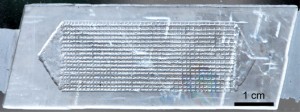Scientists in Canada have developed a new microfluidic model carved from rock, which can replicate the conditions found in underground oil reservoirs in a laboratory with more accuracy than ever before. Using it to study the processes that occur in these reservoirs could lead to greater oil yields.
David Sinton’s group, at the University of Toronto, hope that the model they’ve developed will allow them to properly study the rock structure, and see how it’s affected by oil extraction techniques. The techniques could then be optimised to make them much more efficient.
To read the full article please visit ChemistryWorld.
Chip-off-the-old-rock: the study of reservoir-relevant geological processes with real-rock micromodels*
Wen Song, Thomas W. de Haas, Hossein Fadaei and David Sinto.
Lab Chip, 2014, Advance Article
DOI: 10.1039/C4LC00608A
*Access is free through a registered RSC account until 13 November 2014 – click here to register











